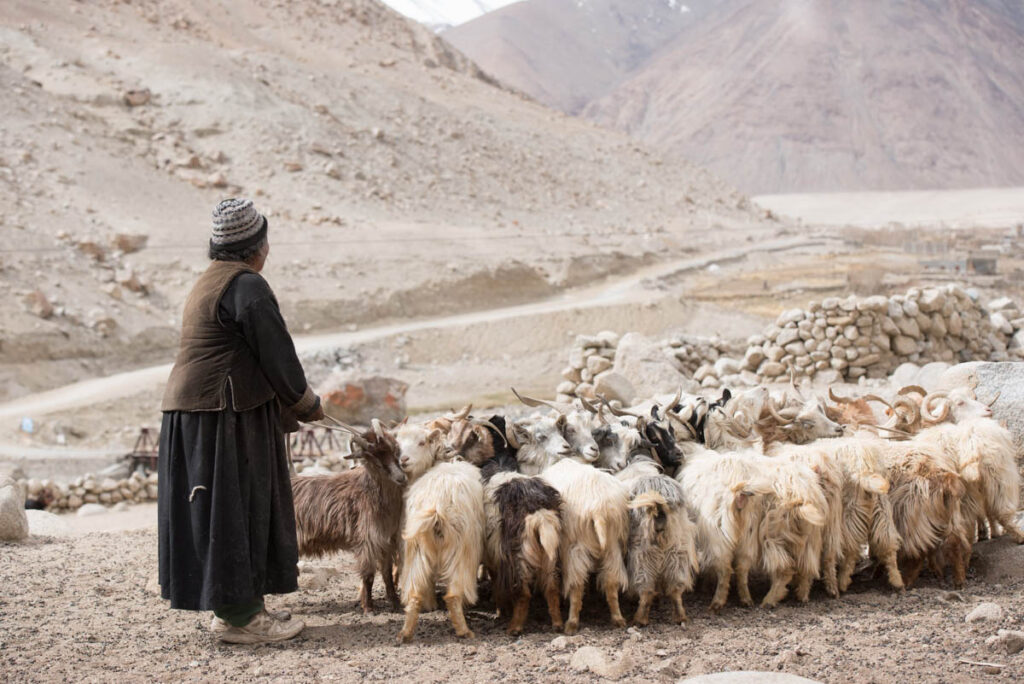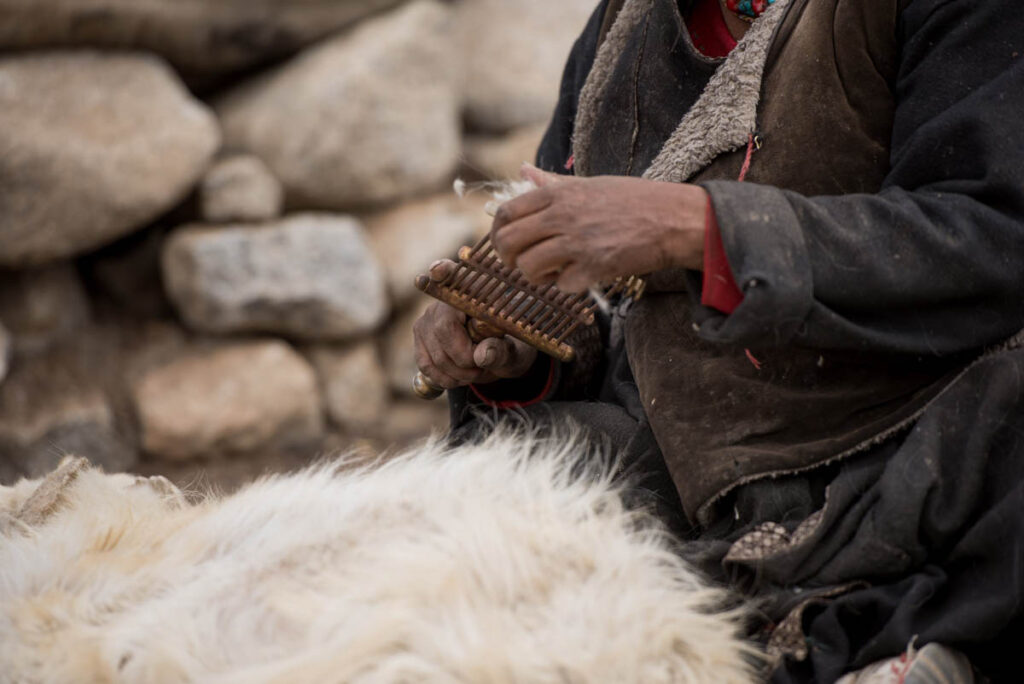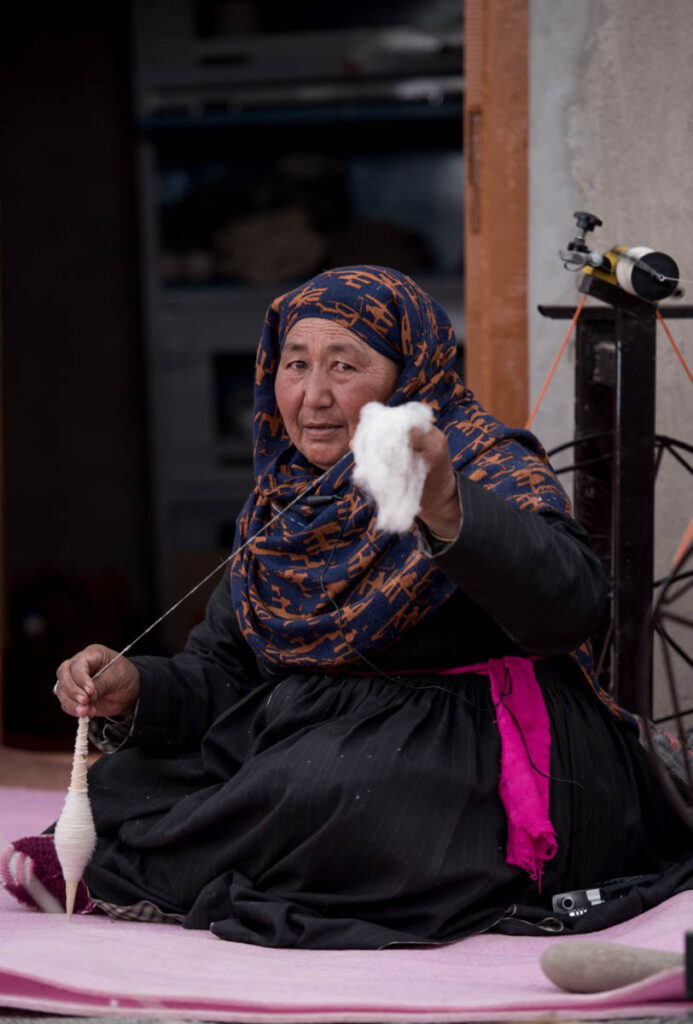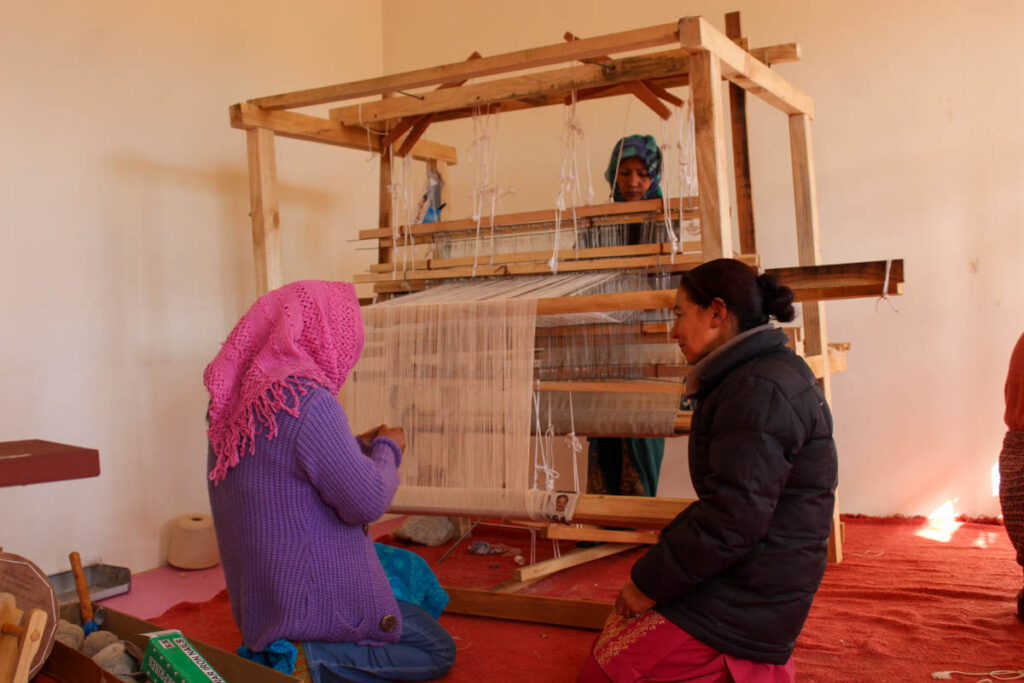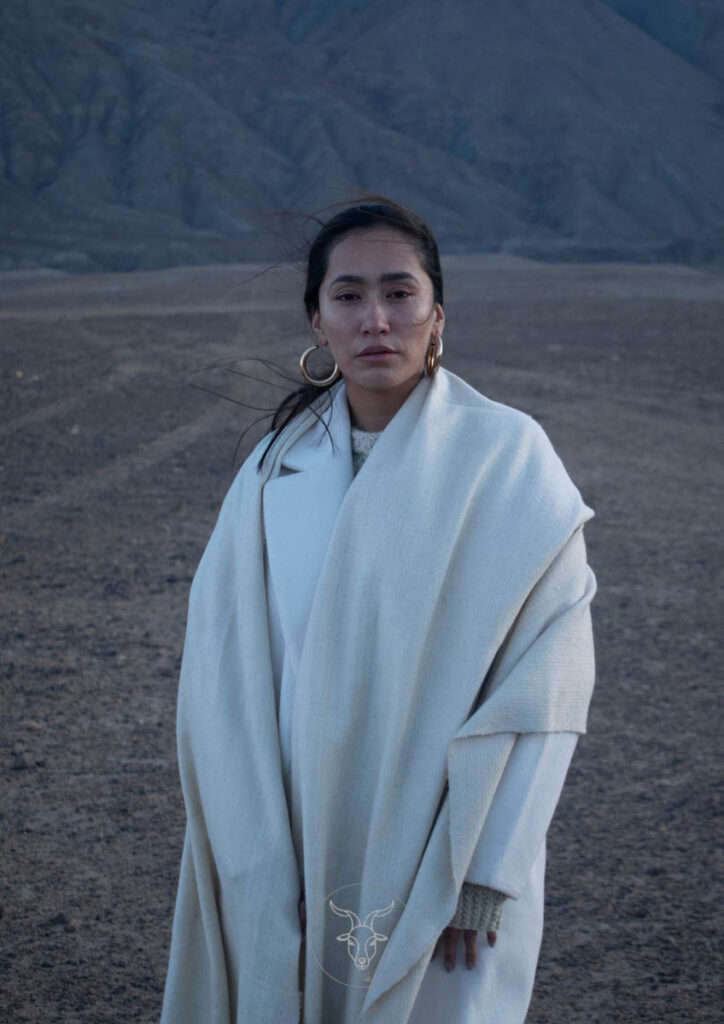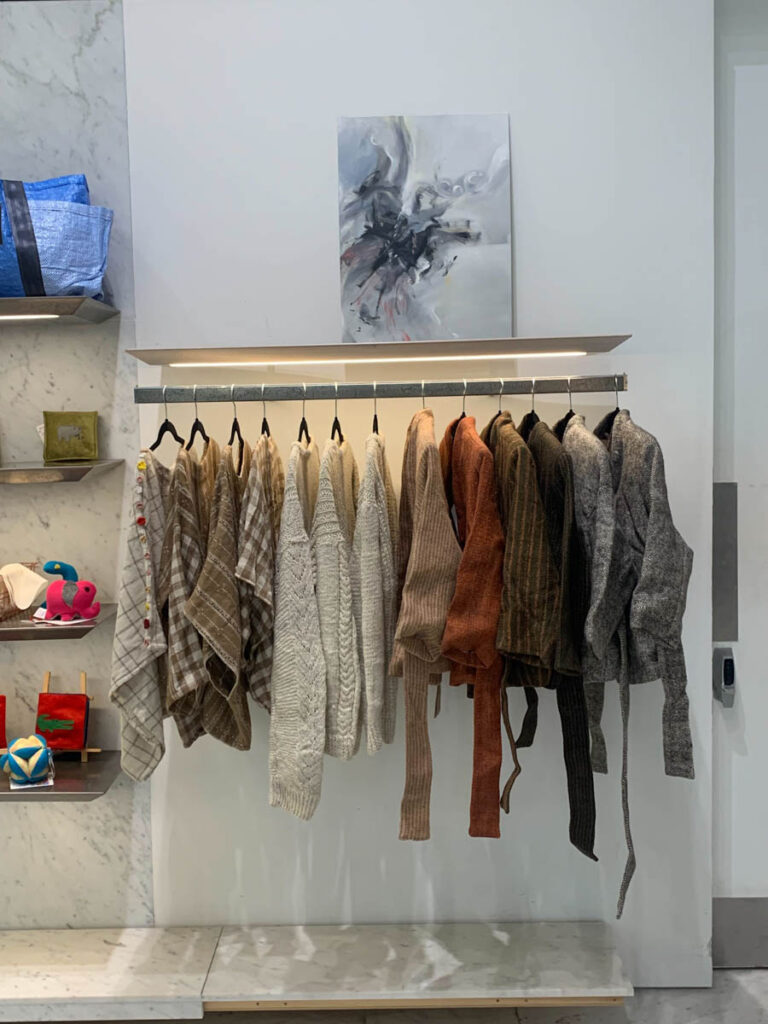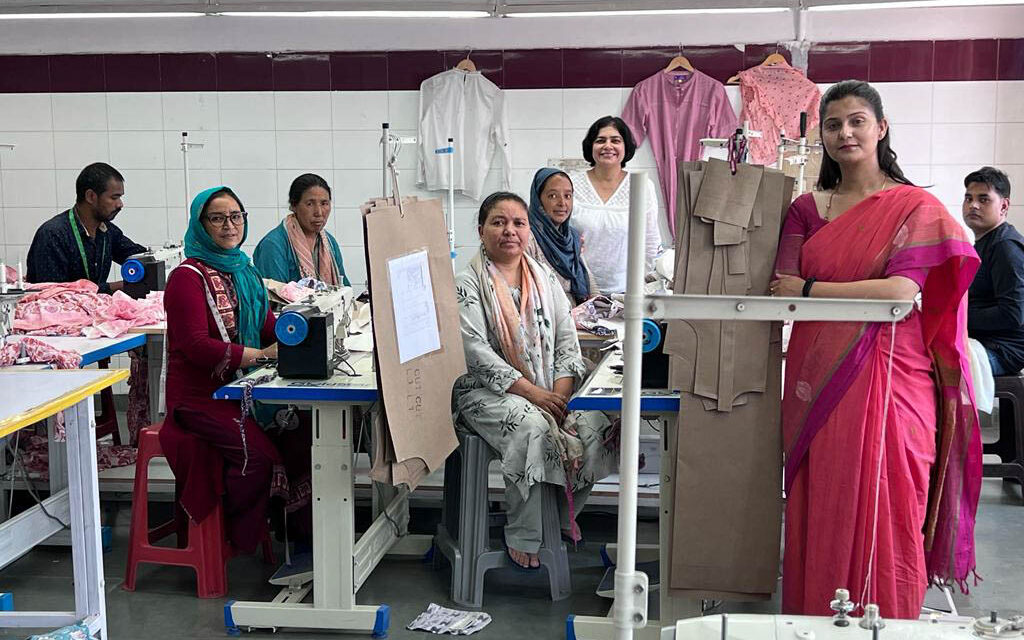
Nalin Rai tells of an association in India’s remote north that creates opportunities for local women by shifting pashmina production closer to the source.
When you conjure the name of Ladakh you link it with images like Psangpo Lake, rugged terrain, motorcycle rallies and Rancho School. But Ladakh and weaving? The image may not gel on the surface.
In recent times Ladakh has emerged as one of the most innovative centres for weaving, focusing on wool-based weaving, including sheep, goat or yak wool, creating a vertical in luxury fibre. The paradigm change that Ladakh is experiencing is on account of the setting up of Looms of Ladakh, a cooperative that is trying to deconstruct weaving in the hills, by choosing Ladakh as the base, to take it out of its traditional image of weaving being a utility based necessity to hand-hold it and facilitate to emerge as a commodity that can compete with any other fabric in any international market. In the context of weaving, Ladakh is now synonymous with the creation of a luxury fibre vertical, the raw material economy being honed for participation in higher-value activities with first-generation artisans.
Building up its base on cutting edge of technology, Looms of Ladakh has evolved as a venture that has ethics imbued in its ethos, and the artisans are mostly herders, who have been trained in such a manner that now they weave out luxury brands with panache from the same looms which earlier were only churning out utility items to facilitate survival in cold and hostile terrain.
The approach that Looms of Ladakh has evolved as a work in progress can offer a blueprint for the challenges being faced by the fashion industry ecologically as also ethically. A herder-artisan-owned brand, it prides itself on upskilling traditional artisans, while continuing to focus on preserving cultural legacies and in the process also spinning out collectibles to give a right hand for, having a pan global appeal.
The story of Looms of Ladakh has its beginnings in 2013 when Abhilasha Bahuguna (co-founder of Looms of Ladakh) became aware of the prevailing state of affairs of the Pashmina artisans. She took the initiative to extend the luxury price tag associated with Pashmina to its creators (weavers). This involved moving the geographical concept of Pashmina in the Kashmir valley to its original base from where the raw material for Pashmina had been sourced for eons. It this as leverage to position the weavers and their product on a global platform. Ladakh was waiting for Abhilasha Bahuguna to usher in this reconstruction of the weaving process and for the weavers the opportunity came when her husband, an IAS ( Indian Administrative Officer), got posted in Ladakh and this posting provided a husband-wife couple with an opportunity to get exposure to weaving and to try and fix its kinks and make it upmarket and stylish!
2017 was the year when Looms of Ladakh evolved as an all-women’s Cooperative. The mandate for setting up the cooperative was to change the mindset that Ladakh can be a raw material supplier only (pashmina), and does not have the wherewithal to provide finished goods. Looms of Ladakh set on a path to change this mindset and now provides livelihood to women residing in remote areas of Leh and Kargil districts.
The trigger for initiating Looms of Ladakh was a topographical change in Ladakh during the last 50 years which eroded access to crucial winter pastures in Western Tibet. There was increased pressure on local grazing resources on account of strategic movements in the area as well as increased tourism along with non-sustainable dependence on the production of Pashm (a rare variety of fine goat wool).
Weaving was a natural activity for the women of the Changpa tribe for centuries, but the arrival of a Moravian mission, which settled down in Ladakh, after being denied permission to go to Tibet, was developed by setting up weaving schools in Ladakh. The weaving schools had flexi-timing factoring in the local conditions. The training by the Moravian Mission was the stepping stone for the weavers to take the first step forward in skill upgradation by adapting Western concepts of weaving.
The second wave of adaptation and diversification was initiated by setting up Looms of Ladakh in Ladakh, which was guided by economics. While the unprocessed pashm grows in Ladakh, its value addition via processing is done in Kashmir, Punjab and elsewhere. While the raw pashm provides an annual income of around $129000 to $155000 per annum, the processed pashm provides an income of $200,000. It underlines the scope for initiating the processing at the base station of Ladakh by selling pashm as clean fibre, or in the form of yarn. Looms of Ladakh entered with this mandate to facilitate refinement in the process of weaving and facilitating enhancement of income for the weavers and initiating the process of building up the brand. The idea of injecting refinement was also facilitated by leveraging the cultural practice of Pashm being an integral part of their which the people of Ladakh are never inclined to share with others. The cultural belief of the weavers of Ladakh about Pashm underlines the rational superiority of the material that they have grown up with, which has been copied for a long time, but the personality of the product rests with the original practitioners or the weavers of Ladakh.
Looms of Ladakh evolved eventually as an all-woman producer organization that has also incorporated traceability in its product base. When the harsh winters set in, as an annual phenomenon between the months of December and February, it is ensured by the Looms of Ladakh that the women are provided sufficient work to tide over those tough times. So far, around 400 women are associated with this initiative.
Looms of Ladakh works on the wisdom of Adam Smith, “The division of the labour is limited by the extent of the market”, and as the market is expanding and diversifying the associated labour force is also diversifying and expanding.
Looms of Ladakh has a democratically elected board that regularly conducts elections within three years of the constitution of the board, the first one was done in 2017, while the second was in 2020, which the women members themselves requested. Manufacturing of a diverse range of products of LL takes place in 22 decentralised villages in Leh and Kargil districts with the distance between villages and Leh town being 10 to 250 kms and the altitude of 9000-17000 feet.
There is a word in Ladakhi, shesrig, which denotes knowledge deemed essential within the culture
There is a word in Ladakhi, shesrig, which denotes knowledge deemed essential within the culture, worthy of being handed down across the generations, and parents pass on shesrig to their children. It includes such skills as knowing how to set camp in the middle of nowhere, start a fire in the cold, cook for one’s survival and so on. The continuum of tradition of weaving underlines the importance of shesrig.
Looms of Ladakh is trying to change the mindset of the fashion industry associated with India, that it can only provide fashionable alternatives in the cotton regime. It is presenting wool as an option, as LL believes that wool available in the form of pashmina, yak, and sheep and has traditionally been woven all across the trans-Himalayan regions of India from Himachal Pradesh to Uttarakhand and in Karnataka through infusion of technology has the potential to rub shoulders with all international wool manufacturers from around the world.
For the uninitiated, it is presumed that Pashmina shawls have their origins in Kashmir, but the fact of the matter is that raw materials that come from the goats are facilitated through the grazing options provided in the high pastures of the Changthang region spread across eastern Ladakh between Leh town and the China border (Tibet).
Looms of Ladakh operates through a three-pronged strategy: focus on natural dyes using natural materials like walnut peels, marigold flowers, tree barks and mountain stones, facilitate in setting up a value chain and augmentation of income by providing resources and training and training staff on operational matters like accounting, merchandising and computers operations to its staff.
It would be the first venture of its kind where weavers take home fifty per cent of the profits, while the rest is used for buying raw materials, inventories, upgrading skills and paying salaries. This situation has arrived after continuous hand-holding of more than six years.
With Sally Holkar’s Handloom School training, and fine skilling by students from the National Institute of Fashion Technology (NIFT) Mumbai in 2019, Looms of Ladakh launches one line each year inspired by the season of Ladakh and not governed by trends or seasons, the basic premise being sustainable clothing can also infuse values of fashion-forward sophistication and quality.
Apart from being sold from its flagship store in Leh, it also finds a place at Taj Hotel outlets in India, and at The Canvas in Manhattan. This Producer Owned Brand is establishing a decentralised apparel manufacturing industry in frontier villages of Leh and Kargil districts through a four-pronged strategy of infrastructure development, capacity building, institution building and brand building—all of it simultaneously. Besides, factoring in the geographical sensitivity of Ladakh, the infrastructure for the hub and spoke model of Looms of Ladakh has been developed keeping in mind the SDG 15 objectives and it harnesses passive solar heating local earth material construction technology is being used for it.
To attain a niche at the international level, standardisation of the fibre is a key component, and Looms of Ladakh is focused on uniformity in the fibre and master craftsmen have been trained who in turn ensure that the backend of weaving becomes standardised and universal.
Looms of Ladakh is a tribute to the spirit of cooperation at the informal levels as well, as it brought along stakeholders from diverse backgrounds, who pooled their energies, and also went beyond their official mandates to see that a brand comes up and makes its mark at the international arena. Among these silent contributors can be mentioned names of Saneev Rohilla and Harsh Deshmukh at NabFoundation, Praveen Prabhakar at Sidbi, Mr Joachim from ICICI Bank, and Tsewang Dolma of Royal Enfield.
References
Nomadic Peoples volume 26 number 2: Commission on Nomadic Peoples; International Union of Anthropological and Ethnological Sciences ISSN: 0822-7942 (print) 1752-2366 (online)
Jones, John Philip and Jones, Mary Baumgartner, Advertisement at the Crossroads: Westland Business, 2021

